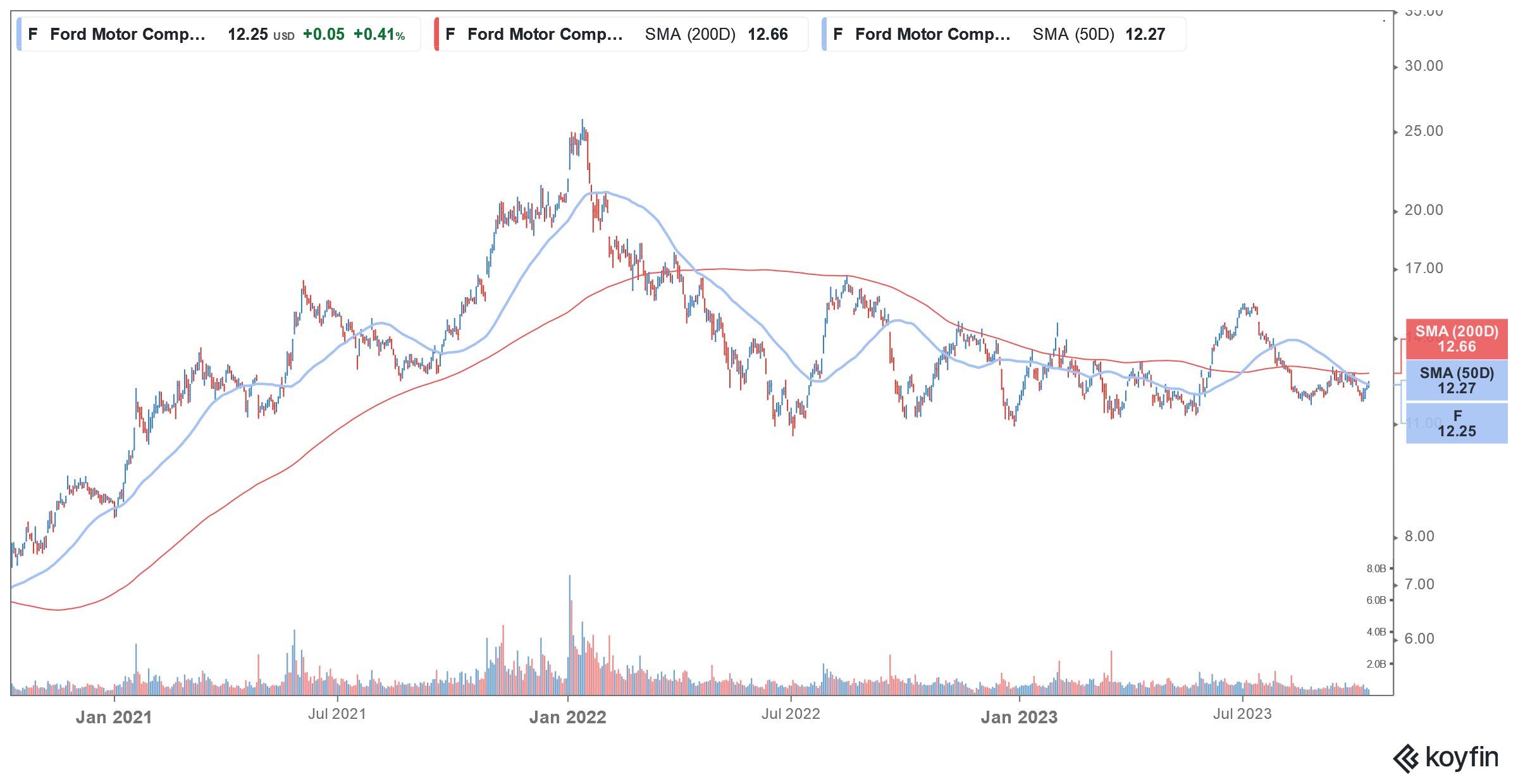Please note that we are not authorised to provide any investment advice. The content on this page is for information purposes only.
Ford (NYSE: F) has announced a massive recall impacting nearly 625,000 vehicles across the US. The recalls stem from two distinct safety issues, namely, a fault with rearview camera displays in Super Duty trucks and a potential safety concern with seatbelt cables in certain Mustangs.
Ford Announced a Massive Recall
The total recall volume is split between two major, separate campaigns. These are.
- Rearview Camera Display Defect (Approximately 291,901 Vehicles): The issue affects several 2020-2022 F-250, F-350, and F-450 Super Duty pickup trucks. A problem with the Image Processing Module (IPMB) software can cause the rearview camera image to be displayed improperly, or not at all, under certain lighting conditions. This degradation in visibility violates Federal Motor Vehicle Safety Standards and increases the risk of a crash while reversing.
- Seatbelt Safety Concern (Approximately 332,778 Vehicles): The issue affects certain Ford Mustang vehicles. The NHTSA notice details that the issue affects a significant number of Mustangs, with some reports citing model years 2015-2017. A design flaw may allow certain sections of carpet to interfere with the seatbelt anchor pretensioner cables, potentially preventing the seatbelt from properly restraining an occupant in the event of a crash. Reports suggest the pretensioner cables are prone to corrosion due to exposure to external elements embedded in the carpet.
Ford has stated that no accidents or injuries have been reported in relation to either of these defects as of the company’s latest internal review.
Ford Disclosed Massive Recall Costs in July
Notably, recall and warranty costs have been a headwind for Ford. While the company has said that it is a legacy issue, they are quite frequent and many times impact newer vehicles. In July, Ford disclosed costs of around $570 million related to the recall of 694,271 crossover SUVs due to a fuel leakage issue.
Fuel injectors in affected vehicles may crack, which could lead to fuel leakage into the engine compartment that poses fire risks. The NHTSA estimates that 0.3% of recalled vehicles, which include 2021–2024 Bronco Sport and 2020–2022 Escape models, may have the defect.
Disturbingly, it was not a new problem for these models. Ford has attempted to address this defect through multiple previous recalls in 2022 and 2024, primarily offering software updates and drain tube installations. However, a year-long investigation by the NHTSA determined that these “fixes” were inadequate as they failed to address the root cause – the faulty injectors themselves. Eight vehicles have already reportedly experienced under-hood fires due to this issue, with six of them not having received the recommended software updates.

Recalls Have Been a Headwind for Ford
Separately, Ford pulled back over 850,000 vehicles, including popular SUVs like the Bronco (2021-2023), Explorer (2021-2023), Expedition (2022), and Lincoln Aviator (2021-2023), as well as various F-Series trucks and the Mustang. The core of this recall lies with the low-pressure fuel pump, which can fail due to internal contamination of the jet pump. This can lead to a loss of fuel pressure and flow, potentially causing the engine to stall while driving and increasing the risk of a crash.
Ford is Focusing on Affordable EVs Amid the Slowdown
Meanwhile, even as Ford’s electric vehicle (EV) business continues to be a cash guzzler and is expected to report an operating loss of $5 billion this year, the company is doubling down on affordable models.
In a move Ford CEO Jim Farley dubbed the company’s “Model T moment,” the company announced its next-generation electric vehicle architecture in August: the Ford Universal EV Platform and a revolutionary new manufacturing process, the Ford Universal EV Production System. This initiative is a high-stakes, multi-billion-dollar bet aimed at slashing costs to deliver a new family of affordable, profitable, and feature-rich electric vehicles, starting with a $30,000 midsize pickup truck.
The new Universal EV Platform is scalable and is expected to underpin a full family of vehicles, including SUVs, crossovers, and commercial vans, with the ultimate goal of making Ford’s electric vehicle business profitable and competitive in the mass market.
US EV Sales Are Expected to Witness a Slowdown
Notably, the US EV industry is going through turmoil, and things are expected to worsen following the withdrawal of the EV tax credit effective this month.
Earlier this week, General Motors (NYSE: GM) announced a $1.6 billion charge in the third quarter of 2025, primarily tied to the strategic realignment of its EV business and manufacturing capacity. This move is a direct response to a reassessment of the US EV adoption rate, which the automaker expects to slow following recent US government policy changes that eliminated the federal EV tax credit.
US EV Sales Soared in September
The US EV market saw a significant acceleration in adoption in September, with sales and market share hitting a new record high for the month. This surge was primarily fueled by a rush from consumers to take advantage of impending deadlines for federal tax credits.
According to market data, the electric vehicle (EV, including Battery Electric Vehicles or BEVs, and Plug-in Hybrid Electric Vehicles or PHEVs) market share of new light-duty vehicle sales climbed to an estimated 12.2% to 13% in September. This is a notable increase from earlier in the year, helping push the overall EV share for the third quarter to a new record of around 10.5%.
Battery Electric Vehicles (BEVs) reached a record market share of approximately 11.8% of all new vehicles sold in September, demonstrating robust consumer interest in fully electric models.

